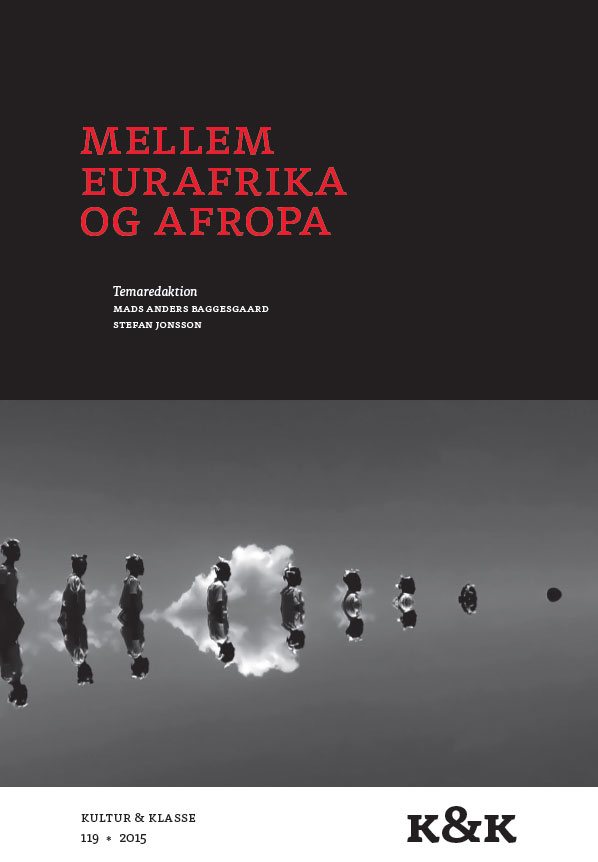Hvem vil vi være? ”Africa for Norway” og den humanitære relation
DOI:
https://doi.org/10.7146/kok.v43i119.22244Nøgleord:
humanitarianism, Radi-Aid, humanitarian emotions, privilege, cultural critiqueResumé
In this article I examine a recurrent critique of humanitarianism and humanitarian phenomena, a critique centering on the presumably anti-political and emotionally complacent nature of such phenomena. But from which position, I ask, does it make sense to critique the humanitarian culture in which we live. In discussing these issues, I take as my point of departure the satirical campaign video Radi-Aid by the fictitious humanitarian NGO, Africa for Norway. This spoof campaign parodies humanitarian aesthetics, humanitarian emotions, as well as the stereotyping typically involved in humanitarian campaigns. Yet, for all its satirizing it does not make a clean break with the very humanitarian culture whose negative aspects it aims to expose. The criticality of the Africa for Norway initiative is thus clearly constrained, but does this imply that the satire is doomed to sheer complicity with the social dynamics it questions? My interest is these issues stems from dissatisfaction with the common notion that a relevant critique of humanitarian relations between the global North and the global South must be a critique of macro level political economy.Referencer
Amos, Jennifer. ”Embracing and Contesting: The Soviet Union and the Universal Declaration of Human Rights 1948-1959.” Human Rights in the Twentieth Century. Red. Stefan-Ludwig Hoffmann. Cambridge: Cambridge UP, 2010. 147-165.
Benthall, Jonathan. ”Islamic Humanitarianism in Adversarial Context.” Forces of Compassion: Humanitarianism Between Ethics and Politics. Red. Erica Bornstein og Peter Redfield. Santa Fe: School for Advanced Research Press, 2010. 99-121.
Berlant, Lauren. ”Introduction: Compassion (and Withholding)”. Compassion: the Culture and Politics of an Emotion. Red. Lauren Berlant. New York and London: Routledge, 2004. 1-13.
Brown, Kimberly Juanita: ”Regarding the Pain of the Other: Photography, Famine, and the Transference of Affect”. Feeling Photography. Red. Elspeth H. Brown og Thy Phu. Durham og London: Duke UP, 2014. 181-203.
Chouliaraki, Lilie. The Ironic Spectator: Solidarity in the Age of Post-Humanitarianism. Cambridge: Polity Press, 2013.
Englund, Harri. ”The Anthropologist and His Poor”. Forces of Compassion: Humanitarianism Between Ethics and Politics. Red. Erica Bornstein og Peter Redfield. Santa Fe: School for Advanced Research Press, 2010. 71-93.
Evans, Erik Schreiner. ”Save Norway!”. The Fletcher Forum of World Affairs, vol 37, nr. 2 (2013): 179-183.
Fassin, Didier. Humanitarian Reason: A Moral History of the Present. Berkeley and Los Angeles: University of California Press, 2012.
Fassin, Didier og Mariella Pandolfi (red.). Contemporary States of Emergency: The Politics of Military and Humanitarian Interventions. New York: Zone Books, 2010.
Fassin, Didier og Richard Rechtman. The Empire of Trauma: An Inquiry into the Condition of Victimhood. Princeton and Oxford: Princeton UP, 2009.
Guilhot, Nicolas. ”The Anthropologist as Witness: Humanitarianism between Ethnography and Critique”. Humanity, vol. 3, nr. 1 (2012): 81-101.
I’Anson, Chioke og Geoff Pfeifer. ”A critique of humanitarian reason: agency, power, and privilege”. Journal of Global Ethics, årg. 9, nr. 1, 49-63.
Jefferess, David. ”Humanitarian Relations: Emotion and the Limits of Critique”. Critical Literacy: Theories and Practices, vol 7, nr. 1 (2013): 73-83.
Kapoor, Ilan. Celebrity Humanitarianism: The Ideology of Global Charity. Routledge 2012.
Manfredi, Zachary. ”Recent Histories and Uncertain Futures: Contemporary Critiques of International Human Rights and Humanitarianism.” Qui Parle, vol. 22, nr. 1 (2013): 3-32.
Manzo, Kate. ”Imaging Humanitarianism: NGO Identity and the Iconography of Childhood.” Antipode, vol. 40, nr. 4 (2008): 632-657.
Mostafanezhad, Mary. ”’Getting in Touch with your Inner Angelina’: Celebrity Humanitarianism and the Cultural Politics of Gendered Generosity in Volunteer Tourism.” Third World Quarterly, vol. 34, nr. 3 (2013), 485-499.
Paulmann, Johannes. ”Conjunctures in the History of International Humanitarian Aid during the Twentieth Century.” Humanity, vol. 4, nr. 2 (2013): 215-238.
Rancière, Jacques. ”Who is the Subject of the Rights of Man?”. The South Atlantic Quarterly, vol. 103, nr. 2 (2004): 297-310.
Robbins, Bruce. ”’All of us without exception’: Sartre, Rancière, and the Cause of the Other.” The Meanings of Rights: The Philosophy and Social Theory of Human Rights. Red. Costas Douzinas og Conor Gearty. Cambridge UP, 2015.
Bornstein, Erica og Peter Redfield (red.). Forces of Compassion: Humanitarianism Between Ethics and Politics. Santa Fe: School for Advanced Research Press, 2010.
Sharma, Devika. ”Det humanitære billede: Renzo Martens og betragterens problem”. KRITIK, årg. 48, nr. 214, København: Gyldendal, 2015 (under udgivelse).
Sharma, Devika. “Privilegiets problem. Mellem den kyniske og den humanitære fornuft”. K&K, nr. 116. Aarhus Universitetsforlag, 2013.
Toscano, Alberto. ”The Tactics and Ethics of Humanitarianism.” Humanity, vol. 5, nr. 1 (2014): 123-147.
Downloads
Publiceret
Citation/Eksport
Nummer
Sektion
Licens
Tidsskriftet følger dansk ophavsret.





